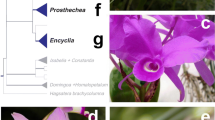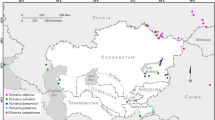Abstract
Relative amounts of DNA were determined by Feulgen cytophotometry in 22 diploid species of Ranunculaceae (n=7, 8, 9) representing six genera, and exhibiting large differences in chromosome size, but no marked differences in karyotype pattern. Chemical determination of absolute amounts of DNA for six of these species, allowed conversion of all the photometric data into absolute units of DNA. The mean DNA content per nucleus varied from.13×10−11gm in Aquilegia to 5.25×10−11gm in species of Anemone in the section Homalocarpus. The DNA values obtained appeared to be “quantized”, and data for the majority of species fitted a non-geometrical series with the observed relative terms: 1—8—12—16—20—24—40. The magnitude of these variations in DNA content, the preservation of the karyotype and the tendency towards a simple numerical progression in DNA values, lead us to prefer an interpretation of the evolution of DNA content in terms of differential polynemy to one postulating changes in size of genetic units in an unchanging number of strands per chromosome.
Similar content being viewed by others
References
Atkin, N.B., G. Mattinson, W. Beçak, and S. Ohno: The comparative DNA content of 19 species of placental mammal, reptiles and birds. Chromosoma (Berl.) 17, 1–10 (1965).
Behre, K.: Physiologische und genetische Untersuchungen an Drosera. Planta (Berl.) 7, 208–306 (1929).
Blackburn, K.B.: Notes on the chromosomes of the Duckweeds (Lemnaceae) introducing the question of chromosome size. Proc. Univ. Durham Phil. Soc. 9, 84–90 (1933).
Boraiah, G., and M. Heimburger: Cytotaxonomic studies on New World Anemome (section Eriocephalus) with woody rootstocks. Canad. J. Bot. 42, 891–922 (1964).
Buttler, J.A.V.: Role of histones and other proteins in gene control. Nature (Lond.) 207, 1041–1042 (1965).
Ceriotti, G.: A microchemical determination of desoxyribonucleic acid. J. biol. Chem. 198, 297–303 (1952).
Chun, E.H.L., N.H. Vaughanjr., and A. Rich: The isolation and characterization of DNA associated with chloroplast preparations. J. molec. Biol. 7, 130–141 (1963).
Fredga, K., and B. Santesson: Male meiosis in the Syrian, Chinese, and European Hamsters. Hereditas (Lund.) 52, 36–48 (1964).
Gall, J.G.: Kinetics of deoxyribonuclease action on chromosomes. Nature (Lond.) 198, 36–38 (1963a);- Chromosomes and cytodifferentiation. In: Cytodifferentiation and macromolecular synthesis. New York: Academic Press 1963b.
Gibor, A., and S. Granick: Plastids and mitochondria: inheritable systems. Science 145, 890–897 (1964).
Gregory, W.C.: Phylogenetic and cytological studies in the Ranunculaceae Juss. Trans. Amer. Phil. Soc. 31, 443–521 (1941).
Halkka, O.: A photometric study of the Luzula problem. Hereditas (Lund) 52, 81–88 (1964).
Heimburger, M.: Cytotaxonomic studies in the genus Anemone. Canad. J. Bot. 37, 587–612 (1959);- Comparison of chromosome size in species of Anemone and their hybrids. Chromosoma (Berl.) 13, 328–340 (1962).
Heitz, E.: Der Nachweis der Chromosomen. Vergleichende Studien über ihre Zahl, Größe und Form im Pflanzenreich. Z. Bot. 18, 625–681 (1926).
Hotta, Y., and A. Bassel: Molecular size and circularity of DNA in cells of mammals and higher plants. Proc. nat. Acad. Sci. (Wash.) 53, 356–362 (1965).
Hughes-Schrader, S., and P. Schrader: Polyteny as a factor in the chromosome evolution of the Pentatomini (Hemiptera). Chromosoma (Berl.) 8, 135–151 (1956).
Joseph, C.K.: Cytotaxonomic studies on Anemone species (section Eriocephalus) with tuberous rootstocks. Ph. D. Thesis, University of Toronto 1964.
Keyl, H.G.: Duplikationen von Untereinheiten der chromosomalen DNS während der Evolution von Chironomus thummi. Chromosoma (Berl.) 17, 139–180 (1965).
Kurita, M.: Chromosome studies in Ranunculaceae I. Karyotypes of the subtribe Anemoninae. Rep. Biol. Inst. Ehime Univ. No 1, 1–10 (1957a); - Chromosome studies in Ranunculaceae II. Karyotypes of the subtribe Cimicifuginae. Rep. Biol. Inst. Ehime Univ. No 1, 11–17 (1957b); - Chromosome studies in Ranunculaceae VI. Karyotypes of six genera. Rep. Biol. Inst. Ehime Univ. No 3, 9–15 (1957c); - Chromosome studies in Ranunculaceae VII. Karyotypes of Eranthis and some other genera. Mem. Ehime Univ., Sect. II, 2, 325–334 (1957d);- Chromosome studies in Ranunculaceae XI. Karyotypes of seven genera. Mem. Ehime Univ., Sect. II, 3, 13–22 (1958); - Chromosome studies in Ranunculaceae XIV. Karyotypes of several genera. Mem. Ehime Univ., Sect. II, 3, 199–206 (1959); - Chromosome studies in Ranunculaceae XVIII. Karyotypes of several species. Mem. Ehime Univ., Sect. II, 4, 251–261 (1961a); Chromosome studies in Ranunculaceae XIX. Chromosome size in Ranunculus species in the eight-chromosome series. Mem. Ehime Univ., Sect. II, 4, 263–268 (1961b); - Chromosome studies in Ranunculaceae XXII. Karyotypes and chromosome-numbers of some species. Mem. Ehime Univ., Sect. II, 5, 31–36 (1964).
Langlet, O.F.I.: Über Chromosomenverhältnisse und Systematik der Ranunculaceae. Svensk bot. Tidskr. 26, 381–400 (1932).
Lewis, K.R., and B. John: Chromosome marker. Boston: Little, Brown and Co. 1963.
Lewitzky, G.A.: The morphology of chromosomes. Bull. Appl. Bot., Genet. Plant Breeding (Leningrad) 27, 19–173 (1931).
Matsuura, H., and T. Suto: Contribution to the idiogram study in phanerogamous plants. I. J. Fac. Sci. Hokkaido Imp. Univ., Ser. 5, 5, 33–75 (1935).
McLeish, J.: Quantitative relationships between deoxyribonucleic and ribonucleic acid in isolated plant nuclei. Proc. roy. Soc. (Lond.) B 158, 261–278 (1963).
Mello-Sampayo, T.: Differential polyteny and karyotype evolution in Luzula: a critical interpretation of morphological and cytophotometric data. Genet. iberica 13, 1–22 (1961).
Mendelsohn, M. L.: The two-wavelength method of microspectrophotometry I. A microspectrophotometer and tests on model systems. J. biophys. biochem. Cytol. 4, 407–414 (1958a); - II. A set of tables to facilitate the calculations. J. biophys. biochem. Cytol. 4, 415–424 (1958b).
Moses, M.J., and G. Yerganian: Desoxypentose nucleic acid (DNA) content and cytotaxonomy of several Cricetinae (hamsters). Genetics 37, 607 (1952).
Ohno, S., W. Beçak, and M.L. Beçak: X-autosome ratio and the behavior pattern of individual X-chromosomes in placental mammals. Chromosoma (Berl.) 15, 14–30 (1964).
Patau, K.: Absorption microphotometry of irregular-shaped objects. Chromosoma (Berl.) 5, 341–362 (1952).
Schmidt, G., and S.G. Thannhauser: A method for the determination of desoxyribonucleic acid, ribonucleic acid and phosphoproteins in animal tissues. J. biol. Chem. 161, 83–89 (1945).
Schrader, F., and S. Hughes-Schrader: Polyploidy and fragmentation in the chromosomal evolution of various species of Thyanta (Hemiptera). Chromosoma (Berl.) 7, 469–496 (1956); - Chromatid autonomy in Banasa (Hemiptera: Pentatomidae). Chromosoma (Berl.) 9, 193–215 (1958).
Stebbins, G.L.: Chromosomal variation and evolution. Science 152, 1463–1469 (1966).
Suyama, Y., and W.D. Bonner Jr.: DNA from plant mitochondria. Plant Physiol. 41, 383–388 (1966).
Swift, H.H.: The desoxyribose nucleic acid content of animal nuclei. Physiol. Zool. 23, 169–198 (1950);- Nucleic acids and cell morphology in Dipteran salivary glands. In: The molecular control of cellular activity (John M. Allen, ed.). New York: McGraw Hill Book Co. 1962.
—, and E. Rasch: Microphotometry with visible light. In: G. Oster and A.W. Pollister (eds.), Physical techniques in biological research, vol. III, p. 354–400. New York: Academic Press 1956.
Taylor, J.H.: The replication and organization of DNA in chromosomes. In: Molecular genetics (J.H. Taylor, ed.), part 1, p. 65–111. New York: Academic Press 1963.
Trosko, J.E., and S. Wolff: Strandedness of Vicia faba chromosomes as revealed by enzyme digestion studies. J. Cell Biol. 26, 125–135 (1965).
Uhl, C.H.: Chromosome structure and crossing over. Genetics 51, 191–207 (1965).
Ullerich, F.H.: Unterschiede im DNS-Gehalt der Genome von Bufo viridis. Z. Naturforschg. 20b, 720–722 (1965); - Karyotyp und DNS-Gehalt von Bufo bufo, B. viridis, B. bufo × B. viridis and B. calamita (Amphibia, Anura). Chromosoma (Berl.) 18, 316–342 (1966).
Author information
Authors and Affiliations
Rights and permissions
About this article
Cite this article
Rothfels, K., Sexsmith, E., Heimburger, M. et al. Chromosome size and DNA content of species of anemone L. and related genera (Ranunculaceae). Chromosoma 20, 54–74 (1966). https://doi.org/10.1007/BF00331898
Received:
Issue Date:
DOI: https://doi.org/10.1007/BF00331898




